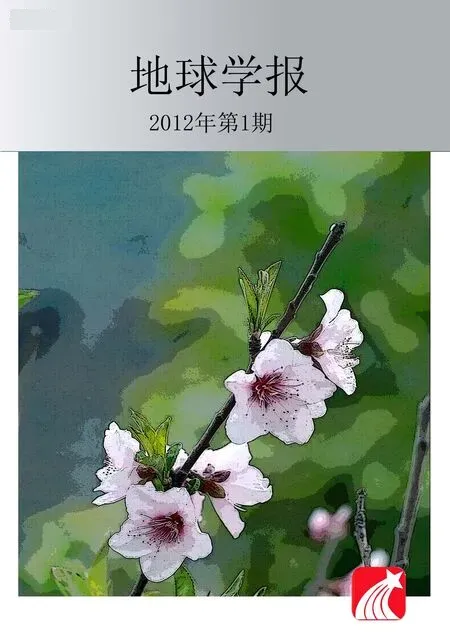藏南定日地区晚白垩世−古近纪地层和盆地演化:对印度和亚洲初始碰撞时间的暗示
藏南定日地区晚白垩世−古近纪地层和盆地演化:对印度和亚洲初始碰撞时间的暗示
*Corresponding author. E-mail: huxm@nju.edu.cn.
This is an extended abstract of Hu et al., 2012.
The timing of the initial collision between India and Asia remains a matter of considerable debate, with views ranging from ~70 Ma to ~35 Ma. Here the initial India-Asia contact is defined as the time at which the edge of the Indian continent margin first underthrust the Asian trench, leading to the complete consumption of the Neotethyan lithosphere, followed by continental subduction.
In southern Tibet, recent palaeomagnetic studies from both sides of the Indus-Yarlung suture zone suggested that the initial contact between India and Asia happened no later than ~50 Ma (e.g. Najman et al., 2010;Yi et al., 2011). These studies have ruled out the model for an Oligocene India-Asia collision (e.g. Aitchison et al., 2007). Cessation of marine facies and the first arrival of Asian detritus happened around ~50 Ma both in Tingri and Saga areas of southern Tibet (e.g. Zhu et al., 2005;Najman et al., 2010; Wang et al., 2011), which constrains a minimum age of ~50 Ma for the India-Asia initial collision.
This paper presents combined stratigraphic, sedimentologic, subsidence and provenance data for the Cretaceous–Paleogene succession from the Zhepure Mountain of southern Tibet. The latest Cretaceous–earliest Paleocene Zhepure Shanpo and Jidula formations record the transition from pelagic limestones into a progradational succession of upper slope to delta-plain environments. The Paleocene–early Eocene Zongpu Formation represents establishment of a stable carbonate ramp,which progressively deepened into an open marine ramp environment. The lower part of the Enba Formation(early Eocene) accumulated in a deeper-water hemi-pelagic setting. The upper part of the Enba Formation records shallowing into a storm-influenced outer shelf

Fig. 1 Cartoon showing the interpreted evolutionary model for the tectonic and stratigraphic development of the early Himalayan foreland basin interpreted in the Zhepure Mountain area of southern Tibet
environment. Detrital zircon U–Pb and Hf isotopic data indicate that the terrigenous strata of the upper part of the Enba Formation were sourced from the Lhasa terrane.Unconformably overlying the Enba Formation is the Zhaguo Formation comprising fluvial deposits with evidence of recycling material from the underlying successions. Backstripped subsidence analysis indicates that the shallowing during latest Cretaceous-earliest Palaeocene time (Zhepure Shanpo and Jidula formations) was driven by relative uplift of basement, followed by stability (Zongpu Formation) until early Eocene (Enba Formation) when accelerated subsidence occurred.Asian detritus and marine to nonmarine environmental transition allow to propose that the Enba and Zhaguo formations would be interpreted as records of Himalayan foreland basin, with the Enba Formation deposited in a foredeep basin while the Zhaguo Formation in a wedge-top basin. Paleoenvironmental analysis indi-cated that the Zongpu Formation was a carbonate ramp which would be interpreted to be occupied on submarine forebulge in a distal foreland basin. The latest Cretaceous-earliest Paleogene tectonic uplift would be either represented by mantle-plume upwelling or flexure forebulge related to oceanic subduction, continental collision or ophiolite obduction. We suggested that the India-Asia initial collision should be happened before the late Danian (~62 Ma) when the Zongpu Formation deposited.
AITCHISON J C, MCDERMID I R C, ALI J R, DAVIS A M,ZYABREV S V. 2007. Shoshonites in Southern Tibet Record Late Jurassic Rifting of a Tethyan Intraoceanic Island Arc.Journal of Geology, 115: 197-213.
HU X, SINCLAIR H D, WANG J G, JIANG H, WU F Y. 2012. Late Cretaceous-Palaeogene stratigraphic and basin evolution in the Zhepure Mountain of southern Tibet: implications for the timing of India-Asia initial collision. Basin Research, 24:520-543.
NAJMAN Y, APPEL E, BOUDAGHER-FADEL M, BOWN P,CARTER A, GARZANTI E, GODIN L, HAN J, LIEBKE U,OLIVER G, PARRISH R, VEZZOLI G. 2010. Timing of India-Asia Collision: Geological, Biostratigraphic, and Palaeomagnetic Constraints. Journal of Geophysical Research, 115,B12416doi:12410.11029/12010JB007673.
WANG J, HU X, JANSA L, HUANG Z. 2011. Provenance of the Upper Cretaceous-Eocene Deep-Water Sandstones in Sangdanlin, Southern Tibet: Constraints on the Timing of Initial India-Asia Collision. The Journal of Geology, 119: 293-309.
YI Z Y, HUANG B C, CHEN J C, CHEN L W. WANG H L. 2011.Paleomagnetism of early Paleogene marine sediments in southern Tibet, China: Implications to onset of the India–Asia collision and size of Greater India. Earth and Planetary Science Letters, 309: 153-165.
ZHU B, KIDD W S F, ROWLEY D B, CURRIE B S, SHAFIQUE N.2005. Age of Initiation of the India-Asia Collision in the East-Central Himalaya. Journal of Geology, 113: 265-285.
Late Cretaceous-paleogene Stratigraphic and Basin Evolution in Tingri area, Southern Tibet: Implications for the Timing of India-Asia Initial Collision
HU Xiu-mian1)*, Hugh D. SINCLAIR2), WANG Jian-gang1), JIANG He-he1), WU Fu-yuan3)
1)State Key Laboratory of Mineral Deposits Research, School of Earth Sciences and Engineering, Nanjing University,China;
2)School of GeoSciences, The University of Edinburgh, UK;
3) Institute of Geology and Geophysics, Chinese Academy of Sciences, China
stratigraphy; basin analysis; Cretaceous; Paleogene; southern Tibet; India-Asia collision
10.3975/cagsb.2012.s1.11

